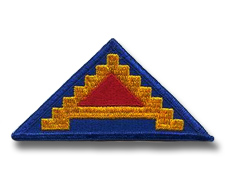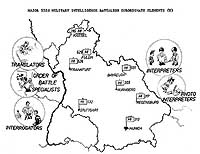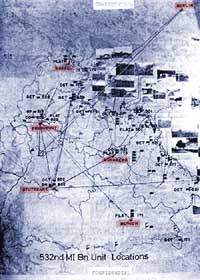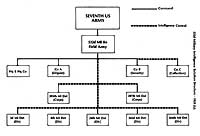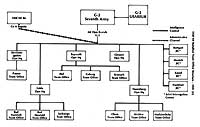| If you do
NOT see the Table of Contents frame to the left of this page, then
Click here to open 'USArmyGermany' frameset |
||||||||||||
|
532nd
Military Intelligence Battalion |
||||||||||||
|
|
||||||||||||
|
||||||||||||
|
|
||||||||||||
| History | ||||||||||||
| 19.. - 1962 | ||||||||||||
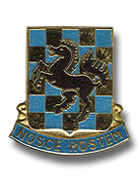 532nd MI Battalion DI
532nd MI Battalion DI |
||||||||||||
| (Source: INSCOM website) | ||||||||||||
| 532nd Military Intelligence Battalion ("Black Horse") The 532nd Military Intelligence Battalion was first constituted on 16 February 1951 at Stuttgart, Federal Republic of Germany, as the 532nd Military Intelligence Company. |
||||||||||||
|
(Source:
US ARMY BORDER OPERATIONS IN GERMANY, 1945-1983, by William
E. Stacy)
|
||||||||||||
| 532nd MI Bn's
Role in Border Operations 1950s In accomplishing the border security mission, an integrated 3-sided team had evolved (by the early 1950s) composed of the armored cavalry regiments, the German border police agencies, and US Army military intelligence units, which provided liaison between the first two, screened refugees who entered the US Zone, and patrolled along the border in order to keep East German and Czechoslovak border security installations under observation. The foreign language capability of the units -- they had Russian, German, Czechoslovak, French, Polish, Hungarian, Bulgarian, and Rumanian linguists -- that was necessary for the accomplishment of their peacetime mission would be fully utilized in wartime when they would accomplish much the same mission -- liaison and interrogation. The units gathered most of their positive intelligence information about East Bloc countries through almost daily liaison with the three German border police agencies and interrogation of refugees. Actually, they normally only screened the refugees and referred approximately 5-6 percent to other agencies for more intensive interrogations. (Refugees -- as used in this section -- includes defectors and illegal border crossers.) During an average year in the 1950s they screened between 20,000 and 30,000 refugees, depending on the flow from the east, and generated from 2,000 to 10,000 reports in response to Seventh Army and USAREUR collection requirements. It should be noted that they only screened approximately 18-20 percent of the refugees, pointing up their dependence on the German agencies to direct likely sources to them. |
||||||||||||
|
||||||||||||
| US military
intelligence resources on the border were strengthened in 1961 under
the Roundout program, when four military intelligence detachments
were assigned to the 532d MI Battallion and attached to the armored
cavalry regiments. Their unit designations, attachments, and locations
were as follows: 172d MI Detachment was attached to the 2d ACR and located at Merrell Barracks, Nuernberg. 501st MI Detachment was attached to the 11th ACR and located at Mansfield Barracks, Straubing. 541st MI Detachment was attached to the 14th ACR and located at Downs Kaserne, Fulda. 181st MI Detachment was attached to the 3d ACR and located at Baumholder Kaserne, Baumholder. (Note: The 501st MI Detachment at Straubing was replaced by the 45th MI Detachment on 19 March 1962.) Now that the armored cavalry regiments had dedicated intelligence resources, on 17 January 1962 their border surveillance mission was expanded to include intelligence evaluation, with an emphasis still being placed on early indications of the imminence of hostilities. The attachment of MI detachments to the armored cavalry regiments was to be a short-lived experiment, however, and they were inactivated (45th, 172d, and 181st) or returned to the United States (541st) like other Roundout units during the last quarter of 1963. Unfortunately, the armored cavalry regiments did not lose the evaluation mission when they lost the MI detachments, and it was essential that they were provided with a minimum capability for processing intelligence information. In order to satisfy this requirement, Seventh Army provided 4-man teams from corps and division military intelligence detachment resources, imagery interpreters from the 2d MI Battalion, and counterintelligence support from 66th Intelligence Corps Group elements located near the ACRs. This whole period in the early 1960s was one of great change for the military intelligence structure and functions in USAREUR, which was only partly manifested bay the establishment of the JICs and the comings and goings of the ACRs military intelligence detachments. By the summer of 1961 it was obvious that a major reorganization of the command's intelligence assets was needed, but the Berlin Crisis and the realignment of intelligence functions at higher headquarters had hampered the necessary planning. In January 1962, however, the USAREUR draft plan for the internal realignment of intelligence missions and organizations was completed. Originally, it was envisioned that the 66th Intelligence Corps Group would be eliminated and that its missions, functions, and assets would be divided between Seventh Army's 532d MI Battalion and USAREUR's 513th Intelligence Corps Group. The two units would be organized and operated in peacetime as they would be in wartime: the 532d would be responsible for counterintelligence functions for the Seventh Army area of responsibility, while the 513th would be responsible for USAREUR's effort to collect military intelligence in the East Bloc countries and the Soviet Union as well as for counterintelligence activities in six Federal Republic areas, thereby centralizing the missions of clandestine collection and offensive counterintelligence in one headquarters. Basically, the plan would allow more MI personnel to be placed in operational positions rather than at headquarters and would insure greater flexibility for meeting peacetime or wartime intelligence missions. However, Seventh Army thought its headquarters control elements were inadequate and the plan was modified, one result being that the 66th Intelligence Corps Group was retained and the 532d MI. Battalion inactivated in its place. The realignments and reorganizations were provisionally implemented on 1 April 1962, pending Department of the Army,approval. The Department of the Army approved the reorganization on 27 April 1962 and, effective 1 June 1962, the 532d MI Battalion was inactivated, the 66th Intelligence Corps Group was reorganized, and the lettered companies from the 532d were redesignated as numbered companies and reorganized. The corps, division, and ACR military intelligence detachments remained attached to the serviced units. The 66th Intelligence Corps Group, assigned to the Seventh Army since 1 April, now consisted of a group headquarters and headquarters company, 5 security companies, 1 collection company and 11 MI detachments; however, only 3 companies were of major importance to the border mission. On the same date the following companies were activated from 532d, assets and assigned to the 66th Intelligence Corps Group: - The 165th MI Company, located in the Frankfurt area, was responsible for the supervision of overt collection in Hesse. In addition to the US element in the Frankfurt JIC, it was responsible for field offices at Bad Hersfeld, Eschwege, and Fulda.* It was composed of 81 officer and enlisted personnel and an unknown number of civilians. - The 503d MI Company, located in Munich, was responsible for the overt collect; on mission in southern Bavaria and supervised the Munich JIC element as well as the Berchtesgaden and Passau Field Offices. It had 81 officer and enlisted personnel plus 10 Department of the Army civilians and 23 "other" civilians. - The 511th MI Company, located in Nuernberg, was-responsible for the overt collection mission in northern, or upper, Bavaria and supervised the Nuernberg JIC element as well as resident offices at Bad Neustadt, Coburg, Kronach, Hof, Marktredwitz, Altenstadt, and Cham. The 511th had 89 officer and enlisted personnel assigned. By the end of 1963, the 165th had picked up supervision of two other JIC elements -- Giessen and Kassel -- and most of the field offices in the 66th that had border responsibilities were being referred to as Border Offices. In addition the Altenstadt Border Office had been relocated to Weiden. It should be noted at this point that the 66th Intelligence Corps Group was responsible for the overall overt collection mission along the eastern borders. Its Overt Collection Division supervised this mission, which was accomplished by the three MI companies that interrogated illegal border crossers, deserters, defectors, refugees, repatriates, resettlers, travelers, and other personnel of intelligence interest who entered the 66th Intelligence Corps Group's area of responsibility (Land Hesse, Land Bavaria, Land Baden Wuerttemberg, and Land Rheinland Pfalz). The Overt Collection Division had been organize during the transition period on 1 May 1962 from personnel of the 532d MI Battalion on the Seventh Army headquarters staff and consisted of two officers, four enlisted personnel, and two Department of the Army civilians. The Border Operations portion of the Overt Collection Division focused on maintaining liaison with the German border police and customs services, screening all border crossers, reporting any changes in the physical features along the border, and investigating and reporting on any incidents occurring in the border area. The overall mission remained the detection of imminence of hostilities or, put more simply to provide early warning of impending attack by hostile forces.28 Each MI company had an Overt Collection Division that supported those elements of the company responsible for the overt collection mission. The overt collection elements within the companies were supplemented by linguist personnel of the 66th's 5th MI Company (Linguist) -- subsequently renamed the 5th MI Company (Interrogation) in FY 1965 -- and the corps and division MI detachments. The latter personnel were attached for peacetime operations only, and would revert to their parent units in wartime. This focus on the eastern borders by the 66th Intelligence Corps Group was further refined in December 1964 when the Frankfurt JIC was inactivated and operational control for the US elements at the Stuttgart and Mainz JICs was transferred to the 513th Intelligence Corps Group. This left the 66th Intelligence Corps Group with supervision of US elements at four JICs near the eastern borders -- Munich, Nuernberg, Kassel, and Giessen. Of note for the future, in FY 1964 almost all of the resident offices with a border mission began to be referred to as Border Resident Offices. |
||||||||||||
|
|
||||||||||||
| (Source: Email from Karl W. Scharl, 532nd MI Bn, 1958-59) | ||||||||||||
| I was a member of the 532nd during the fall of 1958 into the winter of 1959. I arrived in Germany some time in August, I believe --- we arrived in Bremen and were taken by train to Stuttgart where after a few days were issued orders to travel to Munich. There was a 'dienstelle' at Sternwartstrasse where we did our work. It was quite a house --- we had a maid, gardener and a cook! On the first floor was the kitchen, reading room, dining room, living room and a "secure" room where we housed our documents --- the living room acted as our commander's office. On the second floor were the bedrooms shared by all of us and on the third floor were the interrogation rooms, where we "interviewed" our "clients".
We would often spend quite a few days debriefing these refugees on their knowledge of any critical areas they had encountered while either living in any iron curtain country or as they were passing through on their way to freedom. We were all in civilian clothes and drove unmarked cars with German license plates (of course everyone knew who we were, as one of our cars was a '57 Chevy!!!!!). We got our supplies from a Kaserne a few miles away and enjoyed the freedom that was associated with our mission --- at that time there was a curfew for ALL military personnel, but we were exempt. We carried "special" identification papers, so that if we were stopped by either the German police or the M.P.'s we could verify that we were allowed to be out at all hours. You can imagine what that did to our young ego's --- in addition we carried 38 caliber handguns, concealed!!!! And at times we met airplanes from Stuttgart carrying very sensitive materials. Othertimes we also carried sensitive materials as couriers, with the satchel chained to our wrists!!! Real spy stuff. After some months, two of us were transferred to Passau at Sechzenerstrasse where we had a house that also housed a group of CIC agents (there were three, I believe). We had a Captain, 1st Lt. and three of us (all enlisted personnel). While there we were assigned to various refugee camps, where we did the screening. Those that we felt had additional information, we forwarded their names to Munich, and in turn the group in Munich would continue interrogation, just as I had done. In addition, we worked, not too closely, with the CIC lads from a unit housed in the same installation (the CIC unit I've also forgotten) as with selected elements of the German border police. Also did some translation work that was then submitted to Stuttgart.. We would also would "drop" code reds on forward US troops near the border --- these were intended to see the readiness of these forward troops in the event of an "invasion". In Passau, we also had a cook and a cleaning woman that came in every so after, under the watchful eye of one of our staff.
While in Passau, I married a German national, as did one on my co-workers. Because of that I lost my top secret classification, and therefore when I was discharged could not get into the CIC, which I had hoped to do. What we do in the name of love!!!!! Since then have been divorced, but remarried. And that's just about the story of my army days. I am still in contact with one of the fellow members of the Passau installation. Oh yes, did my basic training at Fort Dix and then on to Fort Hollabird in Dundalk, Maryland. Fort Hollabird was like a college campus, where we had free range to leave the compound and explore the surrounding areas and Baltimore. While there I had my car and would "hit" all the rowdy areas of Baltimore, and at that time there were many!!!! |
||||||||||||
| (Source: Several emails from Bill Ward, Hq Co, 532nd MI Bn) | ||||||||||||
| In the 1961 reorganization
the 66th MI Gp was assigned to 7th Army and took over the overt collection
operations, mainly screening border crossers, of the 532d
MI Battalion which was deactivated. I was Headquarters
Company Commander of the 532d at the time of the reorganization and
had the great fortune to be given the job of organizing the CI Special
Operations Branch of G2, 7th Army. That reorganization was a real cat fight. As I remember, the 66th appeared to be on the chopping block after several years of in-fighting with the 513th. When the decision was made and the 532d was to be no more, the message back to Wallace was along the lines of "Don't sell the punchbowl, we won". The 66th absorbed the personnel and assets of the 532d with the exception of the HUMINT people in C Company. They were already working in the 513th. The so-called 'Van Atta Line' was generally seen as a joke, at least at the operating level. This reorganization came on the heels of an major influx of personnel as a consequence of the Berlin Wall which served to exacerbate the situation for a while. Bob Frazier was the Operations Officer of the 66th at the time and is still living in England, I believe. At the time of the reorganization the 532d, mostly A Company linguists, co-ran , with West German counterparts, interrogation centers in Frankfurt, Munich, Nuremberg and, I think, Stuttgart. They also had team houses at Passau, Coberg, Berchesgarten (SP), and several other places along the border. The CI B Company had field office at Vaihingen (7th Army HQ), Mannheim and a couple of other locations. The Detachments were with their assigned units, Corps and Divisions. C Company I mentioned before. H&H Company staffed the Battalion HQ , including a large production element, and the G2 Section at 7th Army. 66th had to absorb all of these activities as well as a liaison office in Bonn. LTC Fred I. Kosaka was the 532d CO at the time of reorganization. Bob Maguire, now living in upstate New York, was the Battalion Adjutant of the 532d and probably remembers more of the details. Bill Ward |
||||||||||||
| 45th Military Intelligence Det | ||||||||||||
| (Source: Email from Thomas C. (Cartter) Frierson, 45th MID, 1962-63) | ||||||||||||
| Thanks for your history of the 532nd. Those early '60's were a time of
constant change for intelligence officers. I arrived in Straubing in
August 1962 after completing the Infantry Officer Orientation Course at
Ft Benning and Intelligence School at Ft Holabird. I had been in Berlin
the previous summer when the Berlin Wall was built in August, 1961. So
it was very interesting to learn that I would spend my active duty stint
on the Iron Curtain as a combat intelligence officer, writing the weekly
intelligence summary for the 11th Cavalry Regiment. Half our unit was in
uniform and were under the operational command of the Cav. The other
half were linguists who lived in the various Border Houses your report
names. I visited some of them with the 45th unit commander, Major John
Shevis, Jr. The 11th Cav under Col. George M. Seignious (recently
deceased) was an elite force and it was very rewarding to serve with
them. Citadel has named a building after retired Brig General Seignious. I had been commissioned into the Quartermaster Branch but assigned to intelligence duty. I did not remember that the 45th MI Detachment had only came into being after I reported for active duty, and I had forgotten the history of the 532nd and the 66th. We were too busy doing live intelligence gathering on the border to pay much attention to the high level turf wars. Besides, we learned in 1963 that the 11th Cav was bound for Vietnam via Ft Dix and the 45th was phasing out as our active duty tours ran down. I was one of the last officers of the 45th MID to leave Straubing. I see where Lt Fred G Myer signed my security debriefing statement the week I departed Straubing for CONUS. Maurice Rawlings and Dick Durant were two other enjoyable officers in the unit. We had close liaison with the Passau and Nuremberg colleagues and our nearby border houses and were in close touch with the German border police, the Bundes Grenschutz and the Bundeswehr authorities operating in Bavaria. There were only a handful of refugees from Czechoslovakia to interview, but their harrowing stories were memorable. One family escaped in a glider, flew over 100 kilometers to reach our border, crossed uneventfully and landed safely on the Danube flood plain near Straubing. The 45th MID was a great bunch of guys. Unfortunately I have lost track of them. Except for the fine web site of the 11th Cav Aviation Company at Mansfield Kaserne in Straubing during the early '60's I have found very little on the Internet about this exceptional front line unit and virtually nothing else about the 45th MID. In August 1963 the 11th Cav commander, Col Kennedy, presented the 45th MID a VII Corps Award for superior service. Those of us in uniform proudly wore the Allons crest of the Black Horse regiment and participated in all field training exercises conducted by the 11th Cav. Those of us in uniform worked under operational command of the Regimental S2, a very competent and enjoyable Captain Crause (sp?). On his staff was Sgt Smolensky, who had been liberated only a few clicks from the post by Patton's troops when Germany fell. I also flew many border patrols in L-19s and a few in H34s as an aerial observer. I'd enjoy hearing from others who served there during those times. I still have a copy of the unit history updated to cover 1943 - 1963 chiefly by the illustrious 1st Lt. Edward Rataj before our Roundout unit was recalled to the United States. We forget many details in the intervening years, but the words like "red drop" and "handicap black" reopen a whole stream of welcome memories of a time when we were the ones who stood in the gap in a high state of readiness and uinit proficiency as the eyes and ears of NATO on the Iron Curtain. We will never know to what degree our vigilance and strength kept the Cold War from boiling over. By the grace of God it never did. I have a treasured piece of the demolished Berlin Wall in my office. |
||||||||||||
|
|
||||||||||||
| Related
Links 511th Military Intelligence Company - Gary Behymer 's memories page for former members of the 511th MI Company (Fürth, Germany) |
||||||||||||
